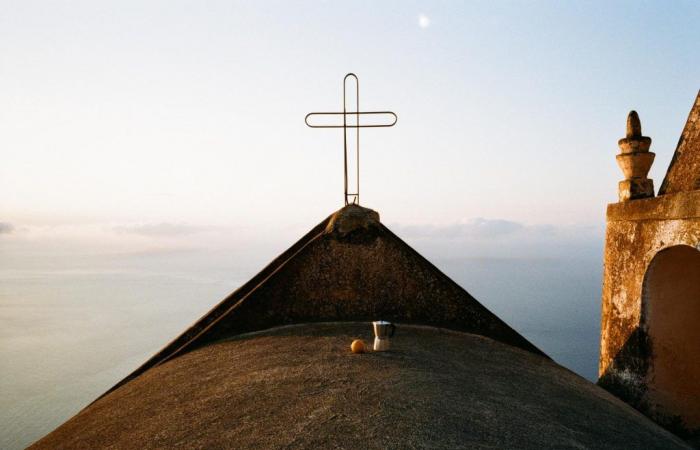The Eye of Photography opens the fifth chapter of the “Cartes Blanches” with the support of MPB. Each month, a French photographer will present an unpublished series of his hands and his eyes, thereby trying his hand at equipment loaned by the international platform for the purchase, resale and exchange of photographic equipment.
Island landscapes definitely feed fascinations. After Mathilde Guihot’s Tudy Island and Cleo-Nikita Thomasson’s Corsica, this new episode in the hands of Marguerite de Tavernost looks at the silvery, purple atmosphere of Alicudi, a small island in the Aeolian archipelagos, north of Sicily. With two lenses lent by MPB, the 28 mm Elmarit wide angle and the 75 mm Summilux, Marguerite de Tavernost anchors her photography in a relationship with light, with stillness and with literature.
“The road passed through the orange groves, the wedding scent of the flowers annihilated all the others as moonlight annihilates a landscape.”
Giuseppe Tomasi di Lampedusa, The Leopard, 1958
Alicudi. Wild Island, Island of Silence.
A story of Marguerite de Tavernost
“We landed on a silvery land. The air all pearled with big drops of water that had fallen asleep on a sea inhabited by lost stars.
The waterlogged lemon trees bend under the weight of their blossoms.
The stone is wet. The rain is incessant.
The night flies away under the pendulum of snails in search of their rediscovered destiny.
The moon is silent. Silence, luminous.
And for good reason. The next day gave way to the warm shadows and sweet air of an island that claims to be sacred.
The earth is revealed, reddened with the blood of its oranges whose ink drips in streams.
The wandering scent of wild herbs preserves the desire to exist of these dried brambles with impulses of freedom.
The honeyed sun of May caresses a solfeggio of swallows and awakens the harshness of the earth.
A harshness that his capers are otherwise devoid of. A tender salty swelling that encompasses the sky in its entirety, a golden drop charged with a celestial powder that undulates on the backs of Silvio’s fish, to end up melting on our palate.
Silvio, precisely. Silvio and Flame, his faithful companion.
Silvio’s boat sails at dawn on a swell of silver bells. Their pious melody sinks into the bell towers devoted to their own abandonment and shakes their high-perched nests.
The sleepy waves of this ardent Sicily strike religiously at our hearts too.
This island as wild as happiness, as furious as this very singular taste of an embraced freedom.
The wild island, the island of Silence, the island with six hundred goats, sixty inhabitants, three mules, a thousand steps, and a hundred cats.
The island of lively marches, flying witches, dancing souls and living rock.
The island of delicate black snakes, flat-palmed cacti, eternal hand lines, growing currents, imprisoned lovers, abandoned lightning, lost hedgehogs, and bewitched seeds*.
The island of burnt grass, bent lemon trees, tanned coffee, and pristine contemplation.
There is only wind and currents here.
The simplicity of this star is disarmingly brutal.
There’s Roberto, too.
Robert of Alicudi. Robert of Capri.
Roberto and his glass silences inspired by insomniac winters
Roberto has lived on this island for over 20 years.
His sensitivity to thunderbolts will open him to the language of the pendulum and to women whose aging souls will find refuge with him, thanks to the little biscuits he leaves in the corners of a cemetery that is never quite asleep. Roberto regularly visits three of them, haunting and singing under their tombstones, pouring out their supposed sins that could have justified such a crash.
Legend has it that one stormy night, one of these women fell asleep with her hand falling on the edge of her bed, which happened to be made of metal. As a result, lightning found its way and struck her. Nonsense, according to him. The legend only serves to disguise the darkness of a murderous husband.
Alicudi is full of legends, swaying steps and half-revealed mysteries.
Its oranges, its coffee, its bell towers, and I hope these few photos will perhaps give you the desire to come and tread this island land with its undulating soul, this incandescent land with its captivating yet haunting rhythm, suspended in the mysteries of an infinitesimal fragment of celestial horizon.
Alicudi is a raw paradise that gets under your skin. A dart that pierces the pulp of your senses, and whose invisible imprint remains intact forever.
“In this secret island, where the houses are carefully closed, where the peasants say they do not know the road that leads to their own village – and it goes over the hill, just a stone’s throw away – in this island, despite an ostentatious luxury of mystery, the reserve is a myth.”
Giuseppe Tomasi di Lampedusa, The Leopard, 1958
Alicudi is full of legends, swaying steps and half-revealed mysteries.
Its oranges, its coffee shop, its bell towers, and I hope these few snapshots will inspire you to come and tread this island land with its undulating soul, this incandescent land with its bewitching yet haunting rhythm, suspended in the mysteries of an infinitesimal fragment of celestial horizon.
Alicudi is a raw paradise that gets under your skin. A dart that pierces the pulp of your senses, and whose invisible imprint remains intact forever.
« On this secret island, where the houses are carefully closed, where the peasants say they don’t know the road that leads to their own village – and it goes over the hill, just a stone’s throw away – on this island, despite the ostentatious luxury of mystery, the reserve is a myth ».
Giuseppe Tomasi di Lampedusa, The Cheetah, 1958
Marguerite de Tavernost
Born in 1991 and living in Paris, Marguerite de Tavernost has refined her eye through numerous reports, which she describes as “intelligent journeys at the mercy of the wind”, letting herself be carried by the unexpected to better delve into the sources where this breath swells.
Her work is based on an exploration of the landscape, its lights and atmospheres as well as its tiny variations, as much as on a more anthropological exploration of the cultures and populations she crosses, like her work in Norway, Kenya, Namibia, Madagascar, Faroe Islands, which she most often explores alone, without a road map. Her practice strictly speaking film allows him to “anchor himself in the poetry of the present moment, to abandon himself to contemplation in its most beautiful simplicity, in its greatest purity.”
Her practice of film plays with, and sublimates, the imperfections specific to films, to the printing, development and fixing process inherent to this method. Marguerite de Tavernost places her artistic approach in the footsteps of Romain Gary and his novel The Roots of Heaven, seeking to reconnect with ” the roots so deep and tenacious that heaven has planted in our hearts.” His series “Alicudi” also echoes Lampedusa’s text, Cheetah, celebrating the magnificence of a flourishing Nature and a voluptuously still Sicily.
The artist, like L’Œil de la Photographie, warmly thanks the MPB photographic equipment resale platform for its support and the loan of two lenses, a 28 mm Elmarit wide angle and a 75 mm Summilux.100. The “Carte Blanche” section could not be done without their help.
“Venus shone, a swollen grape, transparent and moist; but already one thought one could hear the roar of the solar chariot rising from the abyss, below the horizon.”
Giuseppe Tomasi di Lampedusa, The Leopard, 1958
—
*The island is known for its various superstitions and mysteries, including its supposedly hallucinogenic bread. This phenomenon is said to date back to the 1900s, when its rye was infected with ergot, a fungus that produces an alkaloid called lysergic acid, which is also the basis of LSD.
More information






